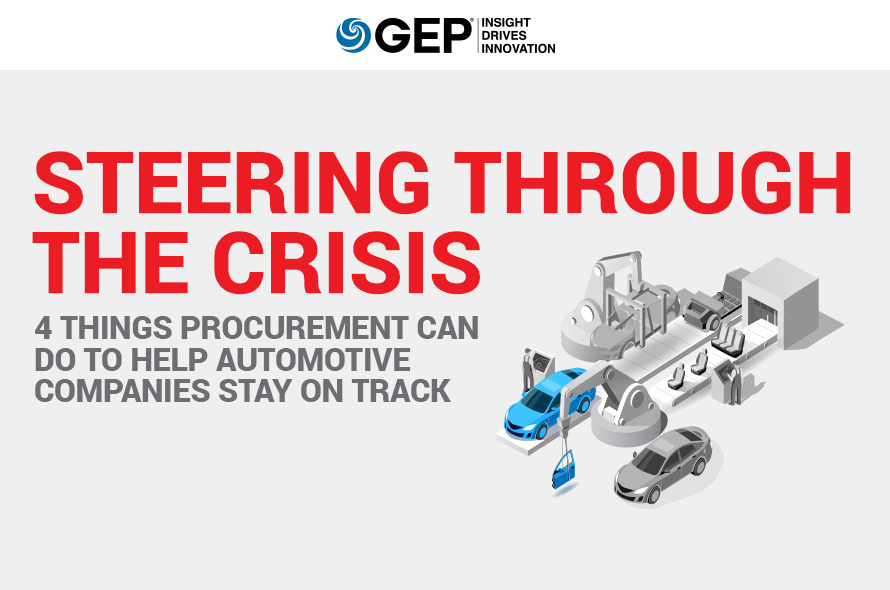As the COVID-19 crisis intensifies, managing automotive supply chains is going to get even more challenging. It becomes all the more imperative to stay focused and build highly resilient supply chains that can absorb the current volatility and financial exigency.
A new GEP Bulletin — Steering Through the Crisis: 4 Things Procurement Can Do to Help Automotive Companies Stay on Track — covers key procurement and supply chain practices that automakers need to implement immediately to manage the impact of the coronavirus.
What’s Inside:
- How to build a resilient automotive supply chain
- How to effectively execute a supply assurance strategy
- How to manage crisis and trigger targeted response
The bulletin provides crucial insights for business leaders in the automotive domain looking to build resilient supply chains that can fight off volatility and risks — get your complimentary copy today.
NAVIGATING UNCHARTED WATERS
The auto industry has weathered its fair share of market shocks and production stoppages in the past (albeit not without government interventions). But the coronavirus’ impact on the auto industry — through all tiers of the supply chain — will likely be more sustained and more precipitous than any disruption the sector has seen since World War II. Ford, GM, Toyota, Mercedes and Daimler have all shuttered plants and the entire auto sector is bracing for extended production stoppages and parts shortages in all major markets.
PROCUREMENT MUST PLAY AN URGENT AND CRITICAL ROLE
The coronavirus is affecting the auto industry, and while no one knows how long the pandemic will last or what the long-term impact on auto sales will be, supply chain professionals have learned enough from previous shocks to figure out the urgent actions that are required. Focus and execution are key now. The extended automotive supply base is adopting a range of approaches to weather the severe economic impact of the coronavirus.
GEP suggests four practices that automakers can execute immediately to manage the coronavirus’ impact on the supply chain:
Protect Your People
COVID-19 is a health crisis, and protecting staff and suppliers from infection is the first priority. Many auto plants have temporarily shuttered while others continue to operate with skeletal crews and strict protocols regarding face-to-face interactions. Procurement can help keep people healthy by:
- Enforcing policies designed to limit the virus’ spread, such as travel and event restrictions
- Sourcing easy-to-use virtual collaboration tools and services that enable more people to work remotely
- Maintaining sufficient stocks of cleaning supplies and personal protection equipment for staff
- Ensuring suppliers adopt new safety requirements, such as sanitizing dollies, re-usable packaging, etc.
Special permits are already required in Italy to identify essential employees who are allowed to travel to work. We expect even tighter restrictions on people’s movement as governments begin to more strictly control curfews and gatherings.
Preserve Cash
Auto producers, already pinched by a slowing market, now face a much more precipitous drop in short-term car sales, plus the risk of a tepid consumer demand recovery in the long term. With high fixed costs to cover, managing cash flow is now a top priority:
- Many firms are taking swift steps to defer discretionary spending, such as fleet upgrades, staff training and plant maintenance
- Some other firms are adopting even stronger austerity measures, including contractor furloughs, warehouse consolidations, indirect spend control towers and budget re-baselining
De-Risk Supply Lines
Critical parts shortage is already impacting auto producers. Fiat Chrysler has had to obtain permission to retrieve key components from a plant shuttered because of the virus crisis in northern Italy. GM has airlifted supplies to maintain truck production. Firms such as Honda and Aptiv have set up crisis response teams that meet daily to monitor global supply risks. As virus containment efforts are currently forecasted to last several months, procurement teams should immediately evaluate all levers to assure supply of critical items and mitigate supplier risks from global hot spots. Supply assurance strategies include:
- Re-sourcing of critical items to tier 2 and tier 3 suppliers
- Holding additional buffer stock closer to plants
- Insourcing critical or long-lead time items
- Expanding the use of alternative parts and substitute materials
- 3D printing of components and spare parts
- Supporting smaller suppliers or those with near-term solvency risks
- Accelerating supplier, equipment and/or tooling qualification processes
- Reviewing business continuity plans with top suppliers and building mitigation plans to clear supply bottlenecks
Seize New Opportunities
“Necessity is the mother of invention,” and in these trying times, new ideas, tools, methods and mindsets can emerge quickly. Enterprises are aligned to a common cause and will more readily adopt new practices as a result. Additionally, supply markets will seek and find ways to get their goods and services to their customers if listened to and fully engaged.
Leading auto and industrial producers will not simply slip into fire-fighting mode; the situation will act as a catalyst for driving sustainable change and building agility into their operating models. They won’t just survive, they will create advantage. Auto firms have already stepped in to help combat the coronavirus by switching lines over to produce respirators, masks and face protection shields for the health care community. We expect new, innovative service models to emerge based on the ways in which many of us and our families are now functioning, such as virtual teaming, remote working and distance learning.
THE BROADER CONTEXT: BUILDING RESILIENCY
In the longer term, auto executives should view the shock of this pandemic as another brutal example of the growing market volatility in which they must operate. Supply chain disruptions are occurring more frequently and with greater severity. Global health risks, extreme weather events, oil shocks, terrorist attacks, migrant flows and civil unrest: they all contribute to new, structural increase in supply chain volatility that auto suppliers must learn to cope with and survive.
The operative word for auto supply chain executives right now is resiliency, that is, the ability to predict, adapt and survive in the face of large, exogenous shocks to their markets and to their communities. Forward-thinking firms will take lessons from this latest crisis and build more resilient supply chains that are better suited for the volatility and risks of today’s operating environment.
| BUILDING A RESILIENT SUPPLY CHAIN | |
|---|---|
| SECURE | The flow of people, goods and data needs to be tracked and protected during crises. Systems and protocols need to be closely monitored and secured. |
| REDUNDANT | Single-point failure mechanisms are too risky for the new normal of high volatility. Back-up suppliers, systems and work methods now need to be enacted very quickly. Business continuity testing must become de rigueur. |
| PREDICTIVE | Supply chain data flows must be harnessed to assess threats from all dimensions and detect risks before they occur. |
| ADAPTIVE | Modern ERP solutions need to sense and respond to a much broader range of factors, learn from prior experiences and adapt in real time to changes in market conditions that impact sales and production plans throughout the extended auto supply chain. |
| STREAMLINED | All of these capabilities will need to be delivered in a highly cost-competitive environment where every dollar counts and where rigorous sourcing and strategic partnering will be key to rapid capability deployment. |
The current supply chain processes and ERP systems are not built for the volatile world we find ourselves in today. Resilient supply chains now require modern, cloud-native, AI-driven tools that are designed to monitor, learn, predict and adapt based on an integrated, 360-degree view of the firms’ supply chain risks. Such improved decision-making tools will be essential to spot risks and seize opportunities in our fast-changing world. In the short term, supply chain professionals must focus on extreme cash preservation and rapid re-sourcing to ensure supplies are unaffected. Firms will need to embrace new tools and methods to make their supply chains far more resilient to market shocks and disruptions in the longer term.
RAPID RESPONSE SOLUTIONS FROM GEP
As the coronavirus crisis intensifies, managing your supply chain is going to get even more challenging. It may be worth finding a partner with deep experience in procurement and supply chain management to reinforce your capabilities and help you stay on course.
If you would like to have a conversation about how we can help, please reach out to our supply chain leadership.

Wayne Clark
Vice President, Global Delivery, GEP
Wayne has over 20 years of procurement and supply chain experience and has led the design and transition of multiple large-scale procurement outsourcing engagements. His areas of expertise include procurement strategy, transformation, organization design, strategic sourcing, collaborative supplier management and strategic change management.

